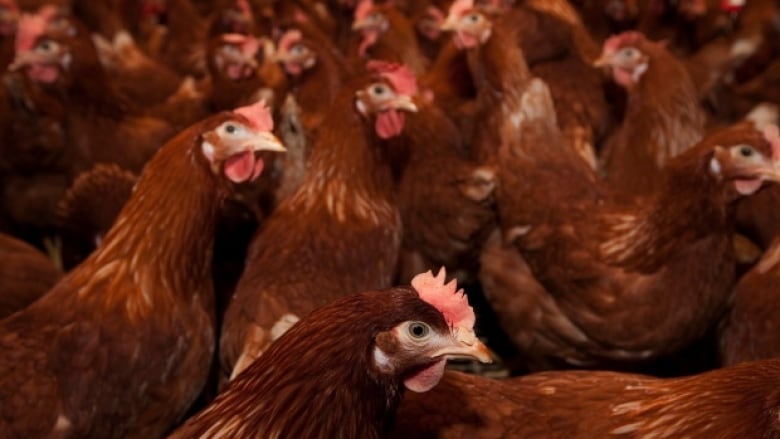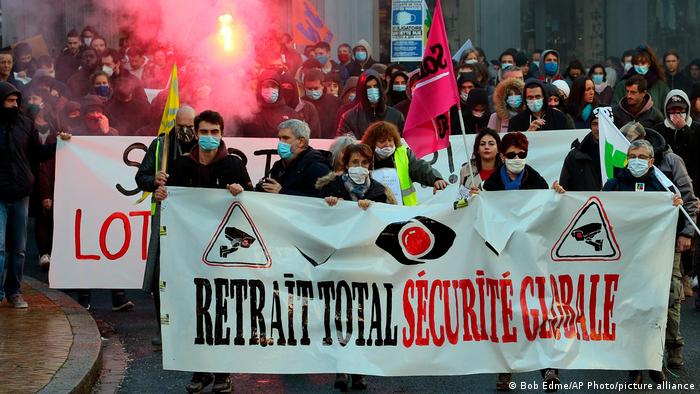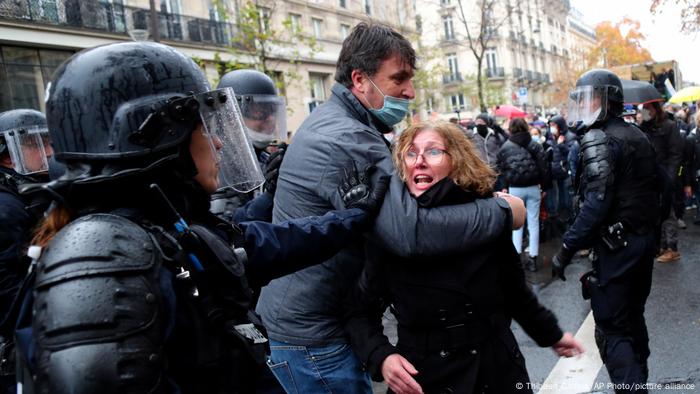'Without enforcement, there is no law': Sask. police, government urged to sanction COVID-19 protesters SO SHOULD ALBERTA
WHITE PEOPLE PROTEST NO RIOT COPS
Regina anti-mask protest planned as 12th care home resident dies and COVID-19 case numbers swell
Jason Warick · CBC News · Posted: Dec 11, 2020


Hundreds attended this rally in Saskatoon last weekend to protest COVID-19 restrictions. A similar event is planned for Regina Saturday. Some are hoping police step up enforcement to stop these potential 'superspreader' events. (Mr. YXE/Twitter)
As the care home death toll mounts and the hospitals fill, hundreds of protesters are planning to descend on Regina to chant and protest without masks against COVID-19 restrictions Saturday afternoon.
Just like an event last weekend in Saskatoon, the Regina protest itinerary appears to violate current public health orders, including the 30-person gathering limit. Aside from the Regina attendees, caravans are being organized to depart from Saskatoon, Weyburn and other locations early Saturday morning.
And like the Saskatoon event, it's unclear whether the Regina Police Service or the provincial government plans to enforce the law through tickets, fines or arrests.
Some worry the unmasked protesters will be "superspreaders" of the virus, and the lack of strong police enforcement is emboldening them.

As the care home death toll mounts and the hospitals fill, hundreds of protesters are planning to descend on Regina to chant and protest without masks against COVID-19 restrictions Saturday afternoon.
Just like an event last weekend in Saskatoon, the Regina protest itinerary appears to violate current public health orders, including the 30-person gathering limit. Aside from the Regina attendees, caravans are being organized to depart from Saskatoon, Weyburn and other locations early Saturday morning.
And like the Saskatoon event, it's unclear whether the Regina Police Service or the provincial government plans to enforce the law through tickets, fines or arrests.
Some worry the unmasked protesters will be "superspreaders" of the virus, and the lack of strong police enforcement is emboldening them.

Criminal lawyer and University of Saskatchewan lecturer Brian Pfefferle says laws have no power if they aren't enforced. Pfefferle says he expects Regina police to be watching closely at the planned anti-mask rally planned for Regina this weekend. (Matthew Garand/CBC)
Lawyer and University of Saskatchewan lecturer Brian Pfefferle said people should not be allowed to openly defy the law without consequences, especially laws designed to protect the health of fellow citizens.
"If a law is in place, it should be enforced," Pfefferle said. "That is, at its core, the rule of law. If we have laws without enforcement, there is no law."
He said police can issue tickets, but they can also break up large gatherings. Pfefferle said Regina police may have to make some tough decisions, but they can't ignore illegal acts.
"If individuals are not charged with flouting the rules, the law has no effect," he said.
Regina cardiologist Dr. Andrea Lavoie is urging protesters to reconsider and stay home.
If they don't, Lavoie agreed with Pfefferle — the laws must be enforced to protect the vulnerable.
She said other rallies in Manitoba and elsewhere have caused large spikes in COVID-19 cases in those communities.
Anti-mask sentiment 'very similar to brainwashing,' prof says in wake of Sask. COVID-19 protest
Teens crash anti-mask mandate protest in Regina
Lavoie, who has worked long hours in Regina hospitals for months, said life has been frustrating for everyone. But endangering your family and community at a protest will make things worse, she said.
"I think we all have to band together in our aloneness and try to follow the rules as best we can so that we can prevent more people from dying or being harmed by COVID-19."

Lawyer and University of Saskatchewan lecturer Brian Pfefferle said people should not be allowed to openly defy the law without consequences, especially laws designed to protect the health of fellow citizens.
"If a law is in place, it should be enforced," Pfefferle said. "That is, at its core, the rule of law. If we have laws without enforcement, there is no law."
He said police can issue tickets, but they can also break up large gatherings. Pfefferle said Regina police may have to make some tough decisions, but they can't ignore illegal acts.
"If individuals are not charged with flouting the rules, the law has no effect," he said.
Regina cardiologist Dr. Andrea Lavoie is urging protesters to reconsider and stay home.
If they don't, Lavoie agreed with Pfefferle — the laws must be enforced to protect the vulnerable.
She said other rallies in Manitoba and elsewhere have caused large spikes in COVID-19 cases in those communities.
Anti-mask sentiment 'very similar to brainwashing,' prof says in wake of Sask. COVID-19 protest
Teens crash anti-mask mandate protest in Regina
Lavoie, who has worked long hours in Regina hospitals for months, said life has been frustrating for everyone. But endangering your family and community at a protest will make things worse, she said.
"I think we all have to band together in our aloneness and try to follow the rules as best we can so that we can prevent more people from dying or being harmed by COVID-19."

Regina cardiologist Dr. Andrea Lavoie is urging protesters to stay home from a planned event in Regina Saturday. She said a large gathering will endanger their family and the community. (Submitted by Dr. Andrea Lavoie)
Lavoie hopes news of a vaccine will give people hope and greater resilience to endure the current restrictions.
An RPS official said they've "reached out to organizers to ensure that they are aware of the public health orders," and police will be monitoring traffic safety.
"We will monitor the event and determine appropriate action, based upon all the circumstances the day of the rally."
Health Minister Paul Merriman was asked by reporters Thursday about the Regina rally and whether there needs to be enforcement of public health laws.
Merriman began by saying that "there's been a lot of rallies that have been held." Merriman then said "people have a right to express themselves," and said he hopes they'll follow the law.
A similar rally was held in Saskatoon last weekend. Saskatoon police escorted hundreds of unmasked protesters up the Broadway Bridge.
On a video live streamed to YouTube, one participant invites others to join, then pans the camera toward the police vehicles escorting the group.
"Cops are leading the march! Cops are leading the march! Anyone who's scared to get a ticket, you won't. Whooooo! Freedom!" she said.
Saskatoon Police Service Supt. Cameron McBride said in an email there is "no police response that will satisfy everyone's unique sense of justice." He said aggressive enforcement can do more harm than good.
"We cannot afford to antagonize an already emotionally charged group of people, who could turn to violence and property damage to make themselves heard," McBride said.
A police official said the investigation is ongoing, but no one has been arrested or charged yet.

Lavoie hopes news of a vaccine will give people hope and greater resilience to endure the current restrictions.
An RPS official said they've "reached out to organizers to ensure that they are aware of the public health orders," and police will be monitoring traffic safety.
"We will monitor the event and determine appropriate action, based upon all the circumstances the day of the rally."
Health Minister Paul Merriman was asked by reporters Thursday about the Regina rally and whether there needs to be enforcement of public health laws.
Merriman began by saying that "there's been a lot of rallies that have been held." Merriman then said "people have a right to express themselves," and said he hopes they'll follow the law.
A similar rally was held in Saskatoon last weekend. Saskatoon police escorted hundreds of unmasked protesters up the Broadway Bridge.
On a video live streamed to YouTube, one participant invites others to join, then pans the camera toward the police vehicles escorting the group.
"Cops are leading the march! Cops are leading the march! Anyone who's scared to get a ticket, you won't. Whooooo! Freedom!" she said.
Saskatoon Police Service Supt. Cameron McBride said in an email there is "no police response that will satisfy everyone's unique sense of justice." He said aggressive enforcement can do more harm than good.
"We cannot afford to antagonize an already emotionally charged group of people, who could turn to violence and property damage to make themselves heard," McBride said.
A police official said the investigation is ongoing, but no one has been arrested or charged yet.

Regina rally promoter Mark Friesen says the event to protest COVID-19 restrictions will go ahead no matter what police do or don't do. (markfriesen.ca) COVIDIOT
Rally promoter Mark Friesen said the Saskatoon event went well. He said Regina's will go on peacefully as planned, no matter what police do or don't do.
"If people want to exercise their rights afforded them under the Constitution, I encourage them to do so," he said.
Friesen repeated many of the claims circulating on social media about the virus, masks and vaccines. He said the public health orders violate his rights to assembly and the right to not wear a mask.
He said the rallies are safe because he's hugged people at them and never gotten sick.
Lavoie said that is not evidence. She urged protesters to educate themselves or find someone to help them understand.
Other jurisdictions have used enforcement as a staple of their COVID-19 plan. In the Australian state of Victoria, which includes the city of Melbourne, 25,000 fines of more than $1,000 each were issued. That region has now been COVID-free for 41 days and is opening its economy and lifting restrictions.
In Saskatchewan, a 12th person died this week at a single Regina care home operation. Daily case averages, hospitalizations and deaths across the province have reached record levels.
According to the latest figures, fewer than 100 Saskatchewan people or organizations have been sanctioned for COVID-19 violations since March.
Protest against mandatory masks in Saskatoon's Midtown mall shut down by police
Rally promoter Mark Friesen said the Saskatoon event went well. He said Regina's will go on peacefully as planned, no matter what police do or don't do.
"If people want to exercise their rights afforded them under the Constitution, I encourage them to do so," he said.
Friesen repeated many of the claims circulating on social media about the virus, masks and vaccines. He said the public health orders violate his rights to assembly and the right to not wear a mask.
He said the rallies are safe because he's hugged people at them and never gotten sick.
Lavoie said that is not evidence. She urged protesters to educate themselves or find someone to help them understand.
Other jurisdictions have used enforcement as a staple of their COVID-19 plan. In the Australian state of Victoria, which includes the city of Melbourne, 25,000 fines of more than $1,000 each were issued. That region has now been COVID-free for 41 days and is opening its economy and lifting restrictions.
In Saskatchewan, a 12th person died this week at a single Regina care home operation. Daily case averages, hospitalizations and deaths across the province have reached record levels.
According to the latest figures, fewer than 100 Saskatchewan people or organizations have been sanctioned for COVID-19 violations since March.
Protest against mandatory masks in Saskatoon's Midtown mall shut down by police
 Kaitlin Geiger-Bardswich was among a team of five people at the organization Women's Shelters Canada, which was tasked with distributing $20.5 million in federal COVID-19 aid to domestic violence shelters in the spring. (Brian Morris/CBC)
Kaitlin Geiger-Bardswich was among a team of five people at the organization Women's Shelters Canada, which was tasked with distributing $20.5 million in federal COVID-19 aid to domestic violence shelters in the spring. (Brian Morris/CBC)







 Werner Bernard says Eden Valley Poultry typically processes about 400,000 turkey and chicken weekly from producers in Nova Scotia and P.E.I. (Jonathan Hayward/Canadian Press)
Werner Bernard says Eden Valley Poultry typically processes about 400,000 turkey and chicken weekly from producers in Nova Scotia and P.E.I. (Jonathan Hayward/Canadian Press)






